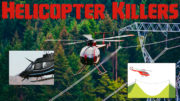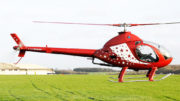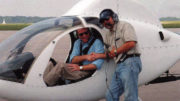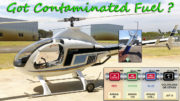Helicopter Student Pilots
As I travel to various parts of the country, providing initial and advanced flight training in RotorWay, Hughes and Schweitzer helicopters I see a consistent problem with the RotorWay students’ endorsements.
If you reccive flight training in a Schweitzer 300CB the flight instructor will endorse your student pilot certificate and pilot log book stating you are safe to solo in that particular make and model helicopter; a Schweitzer 300CB. As a student pilot that endorsement allows you to fly only that specific make and model of helicopter.
You are not legal to hop into a Robinson R22 Beta, as a student pilot, until an authorized flight instructor provides the required training and endorses your student pilot certificate and log book for that specific make and model of helicopter.
Where things get a bit confusing for the student pilot is when they have built and registered their own helicopter, such as a RotorWay, Ultrasport or Safari. I have noticed that most of the RotorWay students that I give Phase II or advanced flight training to have improper endorsements in their log books and on their student pilot certificates.
If you are a student pilot you may want to check to see that your flight instructor has endorsed you to fly your particular individual helicopter to make things LEGAL in terms of the FARs and to insure that your insurance actually covers you.
According to FAR 61.87(1), “Limitations on student pilots operating an aircraft in solo flight. A student pilot may not operate an aircraft in solo flight unless that student pilot has received:
-
(1) An endorsement from an authorized instructor on his or her student pilot certificate for the specific make and model aircraft to be flown; and…
-
(2) An endorsement in the students logbook for the specific make and model aircraft to be flown by an authorized instructor who gave the training within the 90 days preceding the date of the flight.”
The specific make and model can be found on your airworthiness certificate and your aircraft registration certificate. You are the manufacturer and as such you decide on the specific Make and Model designations that you assign to your helicopter. My own RotorWay Exec 90 is registered as Manufacturer (Make): Neisingh and Model: 001.
It is no longer a Rotorway Exec 90 as far as the FAA is concerned because RotorWay is not the manufacturer, I am the manufacturer and I registered it with a specific make and model of my own designation. If you have registered your RotorWay helicopter as a SAM SMITH EXEC 162F, your student pilot certificate and log book endorsements must be for that specific make and model of aircraft.
From what I have seen in student log books the RotorWay Factory flight training school has only been endorsing their students to fly a “RotorWay EXEC 90/162F” or something similar to that. Be sure that you have them endorse your paper work for your own particular MAKE and MODEL of helicopter, in most cases it is not a RotorWay 162F once registered.
When I give a student initial flight training or any other phase of training I always endorse their student pilot certificate and log book with their own specific aircraft Make and Model listed. Once the endorsements are correct and the proper training has been received, the student pilot can be confident that they are in full compliance with the FAR’s.
There is a clause on most aircraft insurance policies that demands that you only fly when you are properly endorsed, have met the currency requirements, that you were endorsed within the preceding 90 days and that you are in compliance with the FARs. Don’t let an incident or ramp check find that you are in non-compliance with the FARs or your insurance policy requirements.
Come on, lets go Flying!!!!!!!!!
The big day is here, you have just finished building your beautiful helicopter, it is registered with your own choice of “N” number, and you have received your airworthiness certificate, operating limitations and are you ever ready to see how this baby flies.
It is now time to enroll in the factory training program, enroll in a flight training school using certified helicopters or arrange to have a flight instructor with RotorWay experience come to your location for initial or transition training.
Should you opt to go the route of training in a certified helicopter and earn your private certificate, you still need to receive some transition training before flying your helicopter.
The RotorWay is not a Robinson or a Schweitzer and it is very easy to get into trouble if you are not familiar with your helicopter’s flight characteristics before taking it up. The factory offers transition training as do a number of CFI’s with RotorWay experience. Get the training and protect your investment to say nothing of your life and limb.
If your flight instructor has a fair amount of Rotorway experience he/she should devote a fair amount of time helping you develop a complete and personalized preflight check list for your particular helicopter in conjunction to the guidelines provided by RotorWay.
Unless I know the owner of a particular homebuilt helicopter extremely well, I will not fly in one unless I accompany that owner as they perform their preflight check to insure that the helicopter meets my own criteria for safety.
Never be in a rush to go flying in your helicopter. A newly manufactured helicopter requires many adjustments and checks to ensure that it remains airworthy. It is your responsibility as the manufacturer and holder of the repairman’s certificate for that helicopter to insure that these checks are done to verify that the helicopter is airworthy prior to each flight.
Make sure you do a rough preflight each time you go flying. You can never be too careful in insuring that your helicopter is good to go. If something doesn’t appear to be 100%, fix it. Once you are airborne it is comforting to know that your helicopter has been meticulously maintained, thoroughly inspected and that you have certified it to be 100% airworthy.
If you hire an instructor to train you in your own helicopter he/she should review the helicopter’s operating limitations with you in detail to ensure that you understand them and are able to comply with them.
Check out your instructor and make sure they have a comfortable amount of flight time in your particular brand of ship and that their credentials are in order. The fact that an individual has thousands of hours in turbine helicopters is no guarantee that they can properly handle your helicopter.
My last student hired a flight instructor having those thousands of hours in helicopters but little or no RotorWay time. On the third flight with the student the instructor lost control of the helicopter and flew it into a line of trees destroying the helicopter and a life-long dream.
My student then rebuilt the helicopter with a professional’s help and asked me to help him with his initial training. To make him even more nervous, while he was at the re-builder’s facility, a fellow, hovering his own RotorWay, experienced a dynamic rollover when a gust of wind caught his tail while hovering downwind. Needless to say, my student was very apprehensive about flight training after what he had experienced and then later witnessed.
With the hours I have flown in the various RotorWay models I am convinced of the following. If the maintenance is impeccably performed, all RotorWay recommendations are complied with and every flight is preceded by a thorough preflight inspection, you will have a helicopter with reliability approaching that of the certified helicopters.
The price that we pay for owning our own kit-built machines is in the maintenance and inspections. Don’t ever assume that the ship is airworthy until you check and prove to yourself that it is airworthy. Safety first is the rule to follow. Remember that your safety and the safety of your passenger is fully your responsibility as the manufacturer and authorized repairman for your helicopter.

Fly safe and enjoy these amazing machines.
Orv Neisingh R/H CFI
Sho-Me Helicopters, LLC







Be the first to comment on "Helicopter Student Pilots With Orv Neisingh"